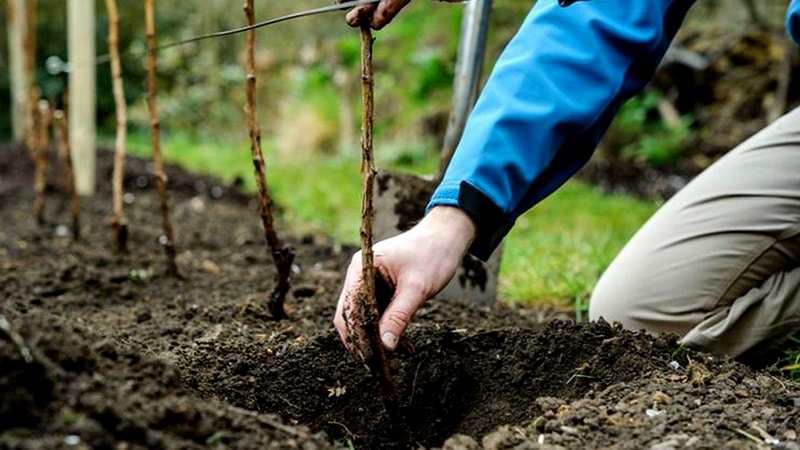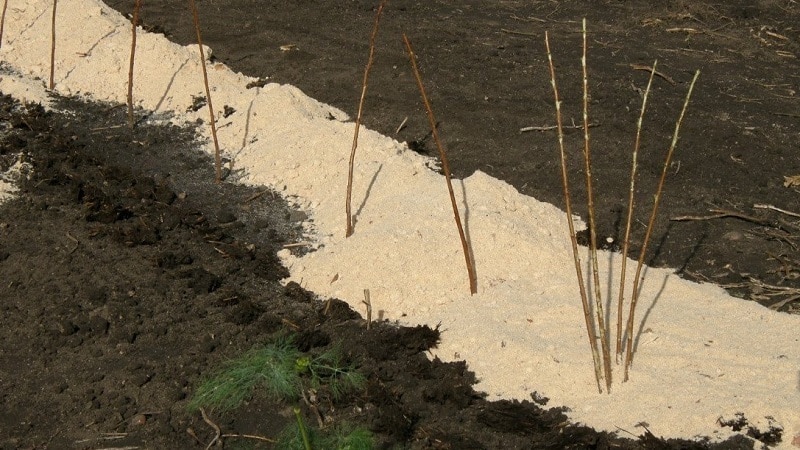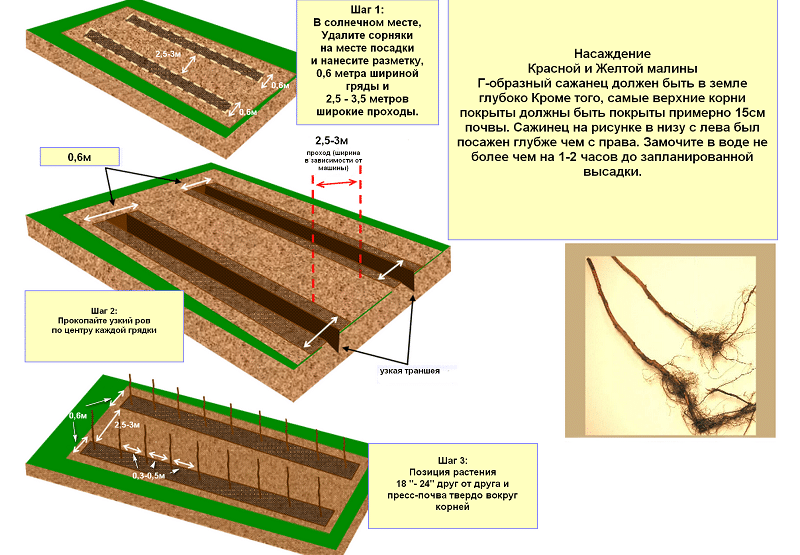Choosing the right planting time: when to plant raspberries so that they take root
Raspberries are an unpretentious crop that develops well in open ground and every year pleases the owner with aromatic berries. That is why it is so loved by summer residents and grows in almost every area. But there are certain nuances that are important to pay attention to when planting. Raspberries are planted in autumn or spring in various ways.
When to plant raspberries
It is recommended to occasionally renew and replant raspberries. Also, many gardeners are breeding new varieties, so it is important to know when is best plant raspberries. If you do this at the wrong time, the crop will not take root well and will most likely die. In addition, untimely planting negatively affects the yield.
Experienced gardeners recommend planting raspberries in spring or autumn.

Advantages and disadvantages of planting in spring and autumn
Land owners often prefer to plant crops in the spring for the following reasons:
- the ground is well moistened;
- seedlings have a lot of time to take root;
- there is no risk of freezing;
- If the seedlings do not take root, it is possible to repeat planting in the fall.
Among the disadvantages is that in the spring the earth is still slightly warmed up, and this has a bad effect on survival rate.
Benefits of autumn planting:
- the earth is well warmed up;
- There will be fruits next season.
Plants planted in autumn begin to grow actively in spring.
Among the disadvantages of autumn planting, experts highlight the risk of freezing of the root system.If frost hits sharply, the seedlings will not have time to take root, which is why they will die.
To reduce risks, it is important to plant no later than 20 days before the expected arrival of frost. Also, additional protection will be mulching the plantings, but this does not always help.
Optimal planting dates and weather conditions
The choice of month depends on the local climate. Most often this is October or April.
In spring, the crop is planted after the snow has melted and the temperature has stabilized, but before the sap begins to flow. The temperature should be between +2 and +10°C. In this case, the plants will survive short-term frosts if they are expected.
Important! It is permissible to plant seedlings with a closed root system even after the buds have opened.
On average, raspberries are planted in spring from late March to late April.
When planting in autumn, the air temperature should be between +10 and +15°C. It is desirable that the air humidity is about 80%.

Nuances for different regions
The exact planting dates are determined based on the climatic characteristics of the region:
- In the southern regions, autumn is late and warm, spring is early and dry. Due to these characteristics of the region, mid-autumn is considered the best time for planting. It is still warm in October, so the seedlings have time to get stronger before frost arrives. It is not advisable to plant in the spring, since due to the high temperature the buds will begin to develop earlier than the roots. There is also little moisture in the ground because winters are usually snowless.
- In the northern regions, autumn comes early. It's cold and rainy. If you plant raspberries at this time, they will not have time to take root. After the arrival of early frosts, the plantings will die.
- In the middle zone, raspberries are planted at any time. Most often, planting is carried out at the end of September. This will give the plants time to take root before frost.But still preference is given to frost-resistant varieties.
Interesting things on the site:
What is the best way to feed raspberries in July for a good harvest?
Instructions for caring for raspberries in summer for beginners
Planting raspberries in spring
There are different planting methods. The choice depends on the preferences of the summer resident. Planting is carried out with seedlings or cuttings.
The main difference between a seedling and a cutting is that a seedling has its own root system, while a cutting is just a cut branch. Planting it will require a lot of effort and time.
Basic planting methods:
- bush;
- into the trench.
If raspberries are planted using the bush method, maintain a distance of 1.5 m between the bushes. The depth of the holes should be about 50 cm, and their diameter should be 60 cm.
Before planting, fertilizers are applied to each hole:
- 40 g ash;
- 4 kg of humus;
- 40 g superphosphates;
- 15 g of saltpeter.
Then the soil is mixed so that the fertilizer is evenly distributed.
In winter, raspberries are bent down and pressed down with something heavy, but stones or earth should not be used.
Planting in a trench is a more labor-intensive process. The gardener will need to spend more time, but the result will not be long in coming.
Before planting, preliminary work is carried out:
- Clear the area of weeds.
- Mark the area.
- Dig a trench 60 cm wide and approximately 50 cm deep.
- A gap of 1.2 m is left between the rows.
- A nutrient cushion of organic matter is placed at the bottom of the trench. It will not only feed the plants, but also warm them.

For the trench, it is best to choose a sunny area. This way the crop will take root faster and produce abundant harvests.
Instructions
It is important to correctly complete all stages of planting raspberries. This is the only way the plants will quickly take root and enjoy a good harvest.
First of all, choose a seedling. It is best if it has a well-developed root. Such a seedling will quickly gain a foothold in the ground. It is important to carefully examine the root. It should not have stains or dry parts that break easily.
The kidneys should be fresh and free of dry parts. In this case, the bush will begin to actively develop. Sometimes plants with dry buds take root, but this happens very rarely.
Landing site requirements:
- The area should be maximally illuminated and protected from strong winds and drafts.
- The shrub cannot be planted in places with high groundwater levels. If moisture stagnates, the root system of the plant will begin to rot.
- It is not recommended to place the crop near currants. It has a well-developed root system, so it will take some of the nutrients from the raspberries.
- It is advisable to place the rows in the direction from north to south. In this case, all bushes will be evenly illuminated throughout the day.
If the location does not meet all of the above requirements, the raspberries will still grow, but the berries will be less juicy and aromatic.
Light soils are best suited for raspberries and other fruit bushes. Most often they contain a lot of minerals. If there is no such soil on the site, you will have to fertilize the plantings more than on light soils.
It is best to start preparing a place for planting in the fall, as this will shorten the time in the spring. Be sure to remove all weeds from the garden bed and apply fertilizer. After this, the ground is leveled and left until spring arrives. In such soil, the seedling will quickly and easily take root.
Planting raspberries in spring includes the following steps:
- Prepare the hole and add fertilizer to it.
- Mix everything thoroughly.
- The roots are straightened and the seedling is lowered into the planting hole.
- Raspberries are watered and covered with soil.
- The top layer of soil is compacted.
- After planting the row, T-shaped supports are installed, between which the wire is pulled.
- When the raspberries grow, they tie them to this wire so that the branches do not fall to the ground.
You cannot plant the plant close to the surface, as the root buds will begin to dry out. Planting is done in such a way that the root collar is at ground level.
Important! The bush should not be pushed too deep into the ground, as it will develop very slowly.
Peculiarities
If spring and summer are expected to be rainy, watering is not necessary. But it is important to ensure that the soil does not dry out. Otherwise, the seedling will wither and die.
After planting, experts recommend cutting the plant to a height of 30 cm. This is required so that the raspberries take root faster. If this is not done, the bush will grow more slowly.
In the first year after planting, young bushes are not fed. They often lack the nutrients that were added to the planting hole.
Planting raspberries in autumn
Many gardeners consider autumn the most favorable period for planting raspberries. Before the first frost arrives, seedlings usually have time to take root. The root system not only becomes stronger, but also has time to grow new roots.

Instructions
Step-by-step instructions for planting raspberries in the fall:
- Dig a trench 60-70 cm deep and about 50 cm wide.
- If the soil in the area is heavy and clayey, a drainage layer 15 cm thick is made at the bottom of the trench. To do this, gravel and sand are laid. Then they make a pillow: first they lay down branches, then fallen leaves, green mass and hay.It is also advisable to sprinkle the pillow with fertile soil or sawdust. This way the layers will ripen evenly and release nutrients.
- The nutrient cushion is thoroughly watered.
- Organic and mineral fertilizers are placed on top.
- After this, the plant is planted. The roots are straightened, the seedling is deepened to the root collar, and covered with soil.
- After planting, the plant is watered and mulched with a layer of at least 10 cm. Peat, sawdust, hay, etc. are suitable as mulch.
Only healthy bushes and trees are chosen as the basis for the nutrient cushion.
Peculiarities
In autumn the plant is not fed. The bushes received all the necessary organic substances and minerals during planting. The food provided in the planting hole will be enough for the bush for 2-3 years.
If raspberries are planted in depleted sandy soil, additional fertilizers are applied immediately after planting. To do this, dig grooves 15 cm deep between the rows. 60 g of superphosphate and 40 g of potassium salt are added to them for each plant. After this, the grooves are filled with water so that the fertilizers dissolve.
Autumn mulching is used from the first year of raspberry life. The plantings are mulched immediately in a thin layer. Before frost arrives, add a thicker layer. This ensures protection of the root system. This is especially important if winters in the region have little snow.
Read also:
Can it be planted in summer?
Summer planting is also acceptable. They resort to it if they did not have time to do it in the spring. However, the plant will not bear fruit this season.
When planted in summer, raspberries also take root well. But in this case, it is important to water it much more often so that the seedlings do not dry out.
Advice from experienced gardeners
Every gardener wants raspberries to be tasty and large, and for a bountiful harvest. This is possible if you follow the following recommendations:
- Traces of pests, diseases and other defects that are on planting material cannot be ignored. It is better to refuse such a seedling.
- There should be no large trees or other bushes near the raspberries.
- It is not advisable to plant the crop in a shaded place.
- Raspberries do not take root well in heavy and clayey soils. This soil is loosened, humus and sand are added to it.
- It is not recommended to plant raspberries immediately after other crops. It is advisable to take a break and give the area a rest.
- Raspberry pruning is carried out carefully so that the procedure does not cause harm to the bush.
Young seedlings need winter shelter, otherwise there is a high probability that they will not survive the frost. In autumn, the plants are bent to the ground, after which they are covered with some kind of insulation. It is used as burlap, padding polyester or sawdust. The choice depends on the climate.
Raspberries grow quickly, and sometimes it is very difficult to get rid of unnecessary shoots. Therefore, gardeners try in advance to limit the growth of the crop. To do this, some sheet material, for example slate, is buried between the rows. It is placed at the same depth as the root system.
It is important to inspect plants periodically for disease or insect damage. Affected branches and leaves are removed. If the bush can no longer be saved, it is destroyed so as not to infect other plants.
If you follow these simple rules, your raspberry garden will delight you with a large harvest of tasty and aromatic berries every year.
Conclusion
Raspberries are an unpretentious crop.If you follow agrotechnical rules, it will grow quickly and produce large yields. The main thing is to choose the right landing time. To do this, it is important to take into account the climatic features of the region.